
In our hyper-connected world, the urge to constantly check for updates, particularly concerning negative news, can morph into a pervasive and detrimental habit known as doomscrolling. This phenomenon, characterized by the compulsive consumption of alarming news and social media feeds, often late into the night, leaves individuals feeling anxious, helpless, and mentally drained. Learning how to stop doomscrolling is no longer a luxury but a necessity for maintaining mental well-being in the digital age. This guide provides actionable steps to reduce doomscrolling habits, offering practical tips to stop doomscrolling and ultimately helping you break doomscrolling addiction.
By implementing these strategies, you can effectively end social media doomscrolling, overcome doomscrolling, and embrace healthier digital habits as part of essential digital detox tips.
The relentless cycle of bad news, amplified by algorithmic feeds designed to maximize engagement, can trap even the most resilient individuals in a spiral of negativity. This guide aims to equip you with the tools to break free.
Understanding Doomscrolling: The Why Behind the Habit
Before diving into solutions, it’s helpful to understand why doomscrolling is such a powerful and sticky habit.
- Our Negativity Bias: Humans have an innate negativity bias – our brains are hardwired to pay more attention to threats and negative information. This was an evolutionary survival mechanism, but in the digital age, it makes us particularly susceptible to alarming headlines.
- The Illusion of Control: In times of uncertainty (pandemics, economic crises, political turmoil), seeking information can create a false sense of control. We believe that if we just know everything, we can better prepare or understand. However, continuous consumption of unactionable bad news often just increases anxiety without providing real solutions.
- Algorithmic Reinforcement: Social media platforms and news aggregators are designed to keep you engaged. Negative and sensational news often generates more clicks and shares, so algorithms prioritize it, creating an endless feedback loop that feeds the doomscrolling habit.
- Availability and Accessibility: Our smartphones put a universe of information, both good and bad, literally at our fingertips 24/7. There’s no physical barrier to entry, making it easy to fall into the scroll.
- Social Connection (or lack thereof): Sometimes, doomscrolling can be a way to feel connected to global events or shared experiences, even if it’s a negative connection. It can also be a way to avoid real-world social interaction or to fill moments of boredom.

Recognizing these underlying drivers is the first step in learning how to stop doomscrolling.
Step 1: Set Strict Boundaries and Time Limits
One of the most effective tips to stop doomscrolling is to impose clear, non-negotiable limits on your news and social media consumption. Treat your digital diet with the same intentionality you would your food diet.
Actionable Strategies:
- Designate “No-Scroll” Zones and Times:
- Mornings: Avoid checking news or social media for the first hour after waking up. Use this time for mindful activities like stretching, reading a physical book, or preparing breakfast. Starting your day with a calm mind can significantly reduce doomscrolling habits later.
- Evenings/Bedtime: Absolutely no news or social media for at least 60-90 minutes before going to sleep. Blue light from screens disrupts melatonin production, and negative news stimulates your brain, both of which sabotage sleep quality. This is a critical step to end social media doomscrolling.
- Meals: Make meal times screen-free. Enjoy your food and any company you might have.
- Social Gatherings: Keep your phone out of sight during conversations with friends and family.
- Utilize App Limits and Screen Time Tools:
- Smartphone Settings: Both iOS (Screen Time) and Android (Digital Wellbeing) have built-in features that allow you to set daily time limits for specific apps (e.g., social media, news apps). Once the limit is reached, the app will lock you out. This is a powerful tool to break doomscrolling addiction.
- Third-Party Apps: Consider apps like Freedom, StayFocusd, or Cold Turkey that can block distracting websites and apps across all your devices for set periods.
- Website Blockers: Install browser extensions that block news sites or social media platforms during work hours or designated focus times.
- Schedule Dedicated “News Check” Times: Instead of constantly grazing for information, decide when and how long you will consume news. For example, allow yourself 15-20 minutes in the late morning and another 15-20 minutes in the late afternoon. Stick to these windows rigorously. This intentional approach helps to overcome doomscrolling by turning passive consumption into active information gathering.
Why it Works: By creating explicit barriers, you disrupt the automatic, often unconscious, reflex to pick up your phone and scroll. These boundaries help retrain your brain to associate certain times and places with non-digital activities, vital for any digital detox tips.
Step 2: Curate Your Digital Environment for Positivity
The content you’re exposed to directly influences your mood and propensity for doomscrolling. Take an active role in shaping your digital feeds. This is an essential step to end social media doomscrolling.
Actionable Strategies:
- Unfollow and Mute Aggressively:
- Social Media: Go through your social media accounts (Facebook, X/Twitter, Instagram, TikTok, etc.) and unfollow or mute any accounts that consistently post highly negative, anxiety-inducing, or irrelevant content. Don’t feel guilty about unfollowing friends or family whose posts consistently trigger you; you can always connect with them directly.
- News Sources: If a particular news outlet consistently publishes sensationalist or excessively negative headlines, consider unfollowing them or reducing your interaction.
- Focus on Value: Prioritize accounts that are genuinely informative, inspiring, educational, or entertaining without resorting to fear-mongering.
- Diversify Your Information Sources:
- Avoid Echo Chambers: While curating for positivity, also ensure you’re not creating an echo chamber. Seek out reliable news sources that offer diverse perspectives, but do so intentionally and within your set time limits.
- Direct Access vs. Algorithmic Feeds: Go directly to reputable news websites rather than relying solely on social media feeds for news, where sensationalism often thrives.
- Newsletters: Subscribe to curated newsletters from trusted journalists or organizations that provide concise summaries, reducing the need to scroll through endless articles.
- Engage with Positive Content:
- Actively Seek Out Uplifting Content: Follow accounts dedicated to good news, inspiring stories, hobbies, humor, or calming aesthetics (e.g., nature photography, art).
- Create “Positive Feeds” or Lists: On platforms like X/Twitter, create custom lists of accounts that only post positive or constructive content. Check these lists instead of your main feed.
- Save & Share Good News: Actively share positive stories with your network to counteract the negativity bias in your own feed and for others.
Why it Works: By consciously shaping what you see, you reduce the triggers that pull you into doomscrolling. A more positive and curated feed makes it easier to resist the urge to endlessly search for bad news, significantly helping to reduce doomscrolling habits.
Step 3: Replace Doomscrolling with Mindful Alternatives
Nature abhors a vacuum. If you simply remove doomscrolling without replacing it with something else, you’re likely to fall back into the habit. Develop a repertoire of healthy, engaging alternatives. These are essential digital detox tips.
Actionable Strategies:
- Engage in Offline Hobbies:
- Creative Outlets: Read a physical book, draw, paint, knit, play a musical instrument, garden, or engage in any hands-on activity that brings you joy.
- Physical Activity: Go for a walk, do some stretching, practice yoga, or clean your living space. Movement can be a powerful antidote to anxiety.
- Social Connection: Call a friend or family member, write a letter, or plan an in-person meet-up. Genuine human connection reduces feelings of isolation that doomscrolling can exacerbate.
- Mindfulness: Practice meditation, deep breathing exercises, or simply sit quietly and observe your surroundings without judgment.
- Cultivate “Mindful Boredom”:
- Resist the Immediate Urge: When you feel the urge to scroll, pause. Acknowledge the feeling without judgment. Instead of automatically reaching for your phone, ask yourself, “What would I do if I couldn’t scroll?”
- Embrace the Pause: Sometimes, moments of “boredom” are precisely what our brains need to rest, process information, and spark creativity. Don’t feel the need to fill every single second with digital input. This is key to learning how to stop doomscrolling.
- Prepare Your Alternatives:
- Accessible Books: Keep a physical book by your bedside or in your bag.
- Hobby Kits: Have your knitting needles, sketchbook, or journal easily accessible.
- Pre-downloaded Content: If you need digital content, ensure it’s positive and pre-downloaded (e.g., a calming podcast, an audiobook, a specific piece of music) so you’re not tempted to browse online.
Why it Works: By intentionally filling the moments where you would typically doomscroll with enriching activities, you create new neural pathways and positive associations. This helps you to overcome doomscrolling by shifting your default behavior from destructive consumption to constructive engagement.
Step 4: Practice Mindful Digital Consumption
Even within your designated news-checking times, change how you consume information. Quality over quantity, and intentionality over passive scrolling.
Actionable Strategies:
- Read Actively, Don’t Scan Passively:
- Choose Reputable Sources: Prioritize well-researched articles from trusted journalists and organizations over sensational headlines or anonymous social media posts.
- Read Deeply: Instead of skimming multiple headlines, choose one or two articles from a reputable source and read them thoroughly. Focus on understanding the facts, context, and potential solutions, rather than just absorbing the negativity.
- Identify the “Actionable” vs. “Unactionable”: As you read, distinguish between information that provides genuine insight or suggests a course of action, and information that is simply sensational or fear-inducing. Focus your energy on the former.
- Check In with Yourself Emotionally:
- Recognize Triggers: Pay attention to how certain types of news or social media posts make you feel. If you notice anxiety, anger, or hopelessness rising, that’s a signal to disengage.
- Set an “Emotional Limit”: Decide beforehand that if a certain piece of news makes you feel overwhelmed, you will stop and take a break. Don’t push through negative emotions just to consume more.
- Practice Self-Compassion: Don’t beat yourself up if you find yourself slipping into old habits. Acknowledge it, reset, and try again. Learning how to stop doomscrolling is a process.
- Avoid Engagement with Argumentative or Provocative Content:
- Don’t Feed the Trolls: Resist the urge to engage in online arguments or read comment sections that are likely to be filled with negativity. This often escalates your own stress levels without being productive.
- Mute Conversations: If a thread becomes overwhelming, mute it. You don’t need to witness every online disagreement.
Why it Works: Mindful consumption transforms a passive, often anxiety-provoking habit into an active, discerning process. By being deliberate about what you consume and how it affects you, you regain control over your digital experience and effectively reduce doomscrolling habits.
Step 5: Reflect, Adjust, and Seek Support
Breaking any habit, especially one fueled by powerful psychological and algorithmic forces, takes time and consistent effort. Regular reflection and, if needed, external support are crucial for long-term success in learning how to stop doomscrolling.
Actionable Strategies:
- Regular Self-Assessment:
- Daily Check-ins: At the end of each day, briefly reflect: “How much time did I spend doomscrolling today? How did it make me feel? What triggered it? What worked well to stop it?”
- Weekly Review: Once a week, look at your screen time data. Are your app limits working? Are there patterns in your doomscrolling (e.g., always late at night, always after a specific event)? This helps you refine your tips to stop doomscrolling.
- Celebrate Small Wins: Acknowledge days when you successfully avoided doomscrolling or limited your exposure. Positive reinforcement helps build new habits.
- Adjust Your Strategies: Based on your reflections, don’t be afraid to tweak your approach. If certain apps are still problematic, increase their time limits. If a particular alternative activity isn’t working, try a new one. Learning how to make a vegan meal plan is an iterative process.
- Communicate Your Intentions:
- Tell Others: Inform trusted friends or family members that you’re working on reducing doomscrolling. They can offer support, accountability, or even suggest shared offline activities.
- Avoid Peer Pressure: If friends are constantly sharing sensational news, politely ask them to send you only the most critical updates or to avoid over-sharing.
- Seek Professional Help (If Needed):
- If doomscrolling significantly impacts your mental health, leads to severe anxiety or depression, or feels impossible to control, consider talking to a therapist or mental health professional. They can provide personalized strategies and support to break doomscrolling addiction and overcome doomscrolling. Addiction to news or social media is a real phenomenon, and professional guidance can be invaluable.
Why it Works: Continuous self-reflection and adaptation ensure that your strategies remain effective and tailored to your evolving needs. Seeking support normalizes the challenge and provides external accountability, which are powerful motivators to end social media doomscrolling and sustain long-term digital well-being.
Conclusion
Doomscrolling is a pervasive modern habit that silently erodes our mental peace and energy. However, by adopting a strategic and mindful approach, you absolutely can reduce doomscrolling habits and reclaim your digital well-being. The journey to how to stop doomscrolling involves setting firm boundaries, curating your digital environment, replacing destructive habits with mindful alternatives, practicing active and critical consumption, and continually reflecting and adjusting your approach.
These actionable tips to stop doomscrolling are more than just quick fixes; they are integral digital detox tips that empower you to break doomscrolling addiction and overcome doomscrolling for good. In taking control of your digital diet, you empower yourself to live a more present, peaceful, and resilient life, free from the incessant pull of negativity.






